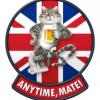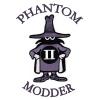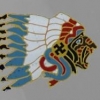Leaderboard
Popular Content
Showing most liked content on 04/27/2022 in Posts
-
3 pointsHere is the first video in my at least three part series: How to WOFF: Getting Started in Wings Over Flanders Fields. Part 2 will cover some basic flight and part three will be about the campaign. Hope it helps someone! Update: Part 2 covering Quick Combat and basic flight... Update: Part 3
-
3 pointsThe Ayres S-2R2 armed Thrush was purchased by the US Army for use in South East Asia in the light utility role. The aircraft was chosen for its strength, simplicity, and rough and short-field performance. It also helped that its agricultural origins meant the USAF did not perceive it as an encroachment on their aerial territory. The aircraft was given the affectionate nickname of "the Flying Lawnmower" due to its exposed radial engine. It was originally delivered in a green and grey paint scheme with high vis markings but was soon painted in a camouflage scheme using the USAF colours in use for the theatre.
-
2 pointsyou have to make it as a gunner station / flexible gun... check my data of AH-64 or AH-1S/P/E/F and above... [TSU-1] SystemType=FLEXIBLE_GUN GunTypeName= MuzzlePosition= 0.00,-11.90, 0.78 LightPosition= 0.00,-11.90, 0.78 MaxAmmo= TracerLoading=0 BurstAmount=0 GunnerID=1 MinExtentPosition=-0.35,-9.50, 0.60 MaxExtentPosition= 0.35,-11.50, 1.50 [TSU-2] SystemType=GUNNER_STATION SeatID=4 GunnerID=1 SetCockpitPosition=FALSE MinExtentPosition=-0.0, 5.68, 0.07 MaxExtentPosition= 0.0, 5.37, 1.02 PitchModelNodeName= YawModelNodeName=TSU GunRange=2500 PitchAngleRate=0 MaxPitch=0 MinPitch=0 DefaultPitchAngle=0 YawLimited=TRUE YawAngleRate=45 MaxYaw=25 MinYaw=-25 DefaultYawAngle=0
-
1 pointI feel like a bit of a test pilot LOL. In an unmodded install, I tried the stock TW A-7, F-4E II, and F-14 on the three blue airfields on the Iceland map. I was getting worried because I couldn't reproduce the problem. But I did eventually figure it out. To address Wrench's question, I started with Single Mission and used the TW mission editor to start my aircraft on a land base. And here is where I created the problem. I started on a land base but I selected the Nimitz to finish the mission on. So take off from land base, land on a carrier in the mission editor causes the problem. If you're wondering "why would he do that!?", I was trying to simulate a student pilot on carrier quals. This seems like a programming thing within SF2 so I imagine the fix for this is "don't do that". Anyway, hope I didn't waste anyone's time. Thanks for chiming in and trying to help. Wizard
-
1 pointI need some help gentlemen. I would like to make the TB2 camera dome to move and if there is a way to have it locked to the selected target or have it look like its moveing and searching. If there is any idea how to do that and if it was make before please let me know. Thanks
-
1 pointI'd be interested in HOW the OP got a Tomcat on a land base on the IcelandNA map. The game has a bit of a 'glitch' in it, wherein any and all maps with "NavalMap=TRUE", proper water bmp with the CV zones, any carrier based aircraft ALWAYS spawn on the boat. It don't work any other way on ALL my installs. just wondering....
-
1 point
-
1 point
-
1 point
-
1 pointCould be that this is due to additional 'video' inside the cockpit. Is this in every Maverick-capable aircraft or some particular one? Try to look into desired aircraft avionics.ini and check values RadarTextureSize=512 TVDisplayTextureSize=512 try to set them to 256 and observe if this changed anything.
-
1 pointI have a crate full of self-sealing stem bolts....where should I put it? GreenHell Vietnam, near Loc Chau exactly...
-
1 pointUnfortunately, the images for my SF Series radar tutorial were split between an old anonymous image shack account that is long gone and a registered one that now requires a monthly fee to manage. I have recovered some of the images from the registered account. The original tutorial is intact in Bunyap's old Weapons Delivery Manual, so if that is still around for download, it has the complete text and images in decent text book format. Since the original knowledge base thread is locked, here is a copy with the salvaged images attached via CombatAce upload. Using radar and radar homing missiles like the AIM-7 Sparrow on Hard settings seems too hard for many people. With a little review of the way radar works and what the display indications mean, it really isn't that difficult. A basic summary: 1. Use Search Mode to detect a target on your display (vary the range scale using the <PAGE DOWN> key if necessary). 2. Use the <HOME> key to move the cursor to the target. 3. Use the <INSERT> key to lock on. 4. Center the steering dot in the ASE circle. 5. Launch when "IN RANGE". 6. Maintain target lock on until missile hits, or missile will miss. Note: Once you have locked on, you can use <CTRL><R> to visually acquire the target, which also identifies the type of aircraft (an unrealistically accurate form of IFF). Then use either <F4> to padlock the target from within the cockpit, <SHIFT><F8> to padlock the target from an external player-to-target view, or <F8> to see the target up close. Alternatively, steps 1 through 3 can be bypassed when engaging targets held visually: Select Boresight Mode and hold your gunsight exactly on the target until a lock on occurs. Then continue with step 4. The idea behind radar in the 1960s was that radio energy could be used to search for contacts by rapidly sweeping an antenna from side to side while transmitting radio energy pulses and receiving "echoes" from targets hit by those pulses. The antenna has a "beam", which is the pattern or shape of the radio transmission. Ideally, this beam is very narrow since it determines the elevation and azimuth resolution. The radar display graphs the azimuth (bearing) of the antenna versus the time (range) of the echoes. In the case of the F-4 radar as portrayed in SFP1 and WOV, the elevation of the antenna alternates between a look up and a look down angle. Each elevation angle is referred to as a bar. The F-4 radar's search pattern in SFP1 and WOV is a 2-bar scan. The F-4 has radar azimuth limits of +/- 60 degrees, which means it can see targets in a 120 degree cone centered on its nose. Illustration of horizontal aziumth sweep pattern: The 120 degree horizontal search cone is quite large, but not every target will be covered by it. There are four ways to get a target into your seach sweep: 1. Arbitrarily change course by +/- 120 degrees to cover a full 360 degrees. In reality, you should know what is behind you, so check turns of +/- 60 degrees is probably adequate. 2. Point your nose at RWR contacts. 3. Steer to the targets in the verbal reports from the ground controller. 4. Use the <M> key to bring up the map to see where to turn your nose to acquire targets known to ground control. The F-4 has radar elevation limits of +/- 60 degrees, but does not scan over that entire range. It merely permits the radar to continue a full horizontal sweep when banked 90 degrees. The vertical search is constrained to two elevation bars at +/- 1.875 degrees. The radar beam is 6.7 degrees wide and the two elevation bars overlap providing about 10 degrees of vertical coverage. Illustration of 2-bar vertical sweep pattern: While this was outstanding for its day, it is easy to see that targets might be above or below the 10 degrees of vertical search. The F-4 must periodically pitch its nose up or down to get more vertical coverage. Of course, the F-4 does not have look-down radar. If the nose is pointed down too much, the radar will be cluttered heavily with ground returns. In reality, the F-4 had major problems trying to use the radar and Sparrow missiles at low altitudes or against targets flying at much lower altitudes. The game is not quite so picky, but a target can try flying very low and using ground clutter to break lock ons and/or decoy Sparrows. Here is a typical search display from an F-4 radar in SFP1 with two targets: Once you have found a target on your search display, you have the option to acquire/track/lock on to the target. This means the radar stops sweeping rapidly and instead tries to keep the antenna pointed at the target at all times. This provides very accurate information on a single target, which is needed to launch and guide radar guided missiles such as the AIM-7 Sparrow. Tracking a single target does not permit searching for more targets. The F-4 radar has a cursor that allows you to choose which target you want to acqire. Press the <HOME> key to move the cursor. If the cursor is not on the desired target, then continue pressing the <HOME> key until the cursor is on the desired target. Here is what happens if you push the <HOME> key while a target is displayed (the cursor moves to the target): Once the cursor is in the desired position, simply press the <INSERT> key to track/acquire/lock on to the target. The sweeping strobe stops on the bearing of the contact, all other targets disappear from the display, and a range gate sweep moves up the strobe until it finds the target's range. At that point, lock on has been achieved. Here is what happens if you push the <INSERT> key while the cursor is on a target (the radar enters acquisition mode): If you successfully lock on, the radar displays additional information: closure rate using a rotating ring, allowable steering error, steering dot, and the min and max ranges of the selected weapon. There is even an IN RANGE light to let you know when the target is within firing range parameters. The notch in the range rate circle rotates to indicate closure rate. If the notch is at 12 o'clock (top of the circle), then there is no closure. As the notch moves clockwise from 12 to 3 to 6 to 9, it indicates an increase in the closure speed. As the notch moves counter-clockwise from 12 to 9, it indicates that the target is opening rather than closing. In other words, the target is moving away from the radar. Here is what the display looks like while locked on: Sparrows have two primary launch requirements: 1. Locked on to the target. 2. Target between Min and Max range limits. But just because you are able to launch a Sparrow, doesn't mean it has a chance of hitting. Other launch requirements that should be considered include: 1. Launching aircraft should not be maneuvering violently. 2. Steering dot should be within the ASE circle. 3. ASE circule changes size with range. In general, the larger the circle, the better the chance to hit. Try to hold fire until the circle is close to its maximum size. 4. Aspect of the target can render Sparrow shots impossible. The AIM-7 likes direct head-on shots form long distances and rear quarter shots from short distances. Crossing shots at the targets front quarter and beam may prove difficult, if not impossible to hit. 8. Launching aircraft should have as high a speed as practical since the missile can maneuver better, fly longer range, and impact sooner if it has more energy at the moment of launch. Here is what the F-4 radar display looks like when close to optimum firing conditions (the ASE circle is very large and the steering dot is almost centered in the circle): If you get too close to fire an AIM-7 Sparrow, the radar displays a big "X" (the phrase "too close for missiles, switching to guns" should come to mind): Vietnam Era RWR Indications: Ground threats are identified by a solid line. Air threats are identified by a dashed line. Radar mode is indicated by the length of the line: 1) Search: short steady line (1st ring) with no audio. 2) Acquisition: flashing medium line (3rd ring) with slow beeping audio. 3) Tracking/Lock-on: flashing long line (to edge of display) with fast beeping audio. Ground radar search: Ground radar acquisition: Ground radar track/lock: Air radar search: Air radar acquisition: Air radar track/lock: If there are any questions or comment, PLEASE only post them in the regular SF2 forums (General Discussion)
Important Information
By using this site, you agree to our Terms of Use, Privacy Policy, and We have placed cookies on your device to help make this website better. You can adjust your cookie settings, otherwise we'll assume you're okay to continue..
















